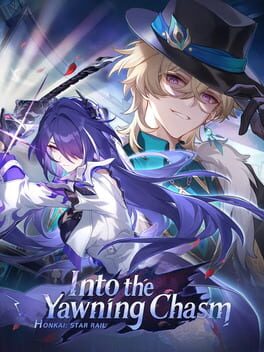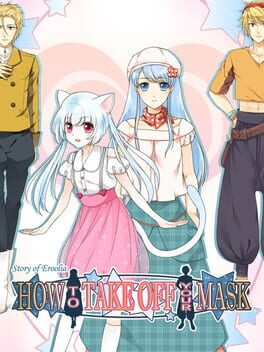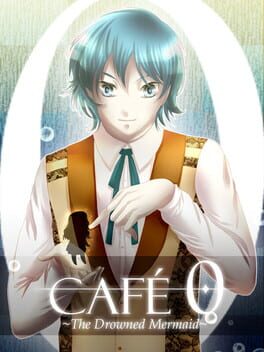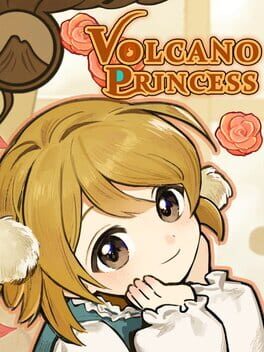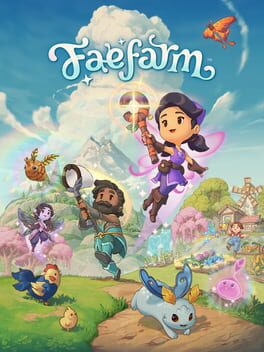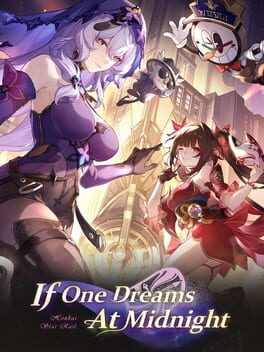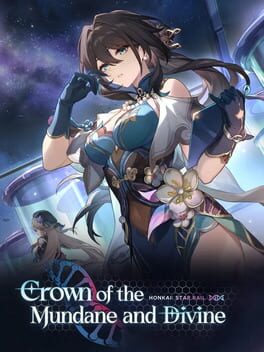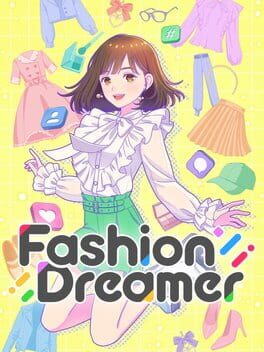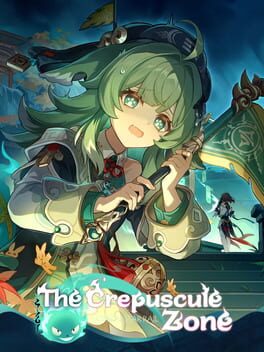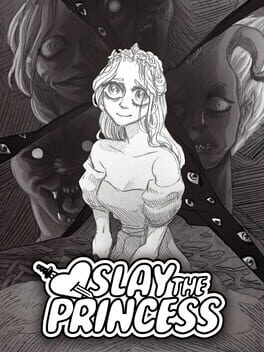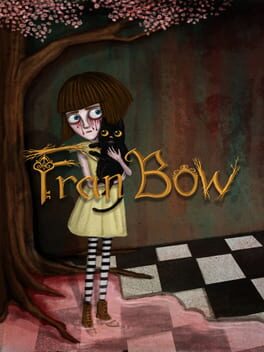confusedmuse
A cute coming-of-age story about learning to be honest about your feelings to the people you care about via the narrative device of waking up one day as a catgirl. How to Take Off Your Mask doesn't break new ground with its storytelling, but within the simplicity lies the charm. These childhood friends are clearly crushing on each other, but their fear of losing the other by being "different" keeps them from being honest, and so the rom-com commences. The story does try to be serious at times, though it undercuts its own plot by not fully explaining what's going on with the group who hates cat people (maybe they do in the other VNs in this series?), but the sugary sweet childhood friends romance is the real star here. I'd recommend this to someone looking for a fluffy low-stakes romance who are willing to accept that they might not get all the questions about this world answered.
Cafe 0 almost had me. At the start, when I realized that Roseverte had created the spiritual successors to the routes from Duplicity by having the player pick between romancing a groomer or a jerk classmate again, I almost quit. But this time around, thanks to the genre shift, the writing in these routes made it clear that this was not meant to be romantic. The routes were pieces to the puzzle of the amnesiac main character's history, and putting them together might mean solving the mystery of her death. In essence, everyone in Cafe 0 is a jerk, and the goal is not for the main character to fall in love so much as it is to see every situation from as many angles as possible to figure out the complicated social web that has led to the murder mystery scenario at the heart of the story. Making it overt that the uncomfortable feeling in these routes is intentional goes an extremely long way in making these characters easier to take than the ones in Duplicity. It's also a quick read - I finished it within an afternoon - and the tighter focus and faster routes work in the story's favor.
Where it all falls apart, however, is how short the final scene is. There's a lot of time spent in the true route clarifying everything and revealing even more secrets, but when the time comes for the main character to take everything she's learned and change her fate...you blink, and it's over. Add that to a strange UI, unpolished art style, and backgrounds inconsistent to what the text is saying about a scene, and Cafe 0 ended up leaving me feeling disappointed despite its compelling story. Maybe it just needed Sui to take more of an active role. I enjoyed his polite sarcasm as the main character's life was unraveling around her. Overall, while this title is a huge step forward for Roseverte from Duplicity, Cafe 0 ended up tripping at the finish line.
Where it all falls apart, however, is how short the final scene is. There's a lot of time spent in the true route clarifying everything and revealing even more secrets, but when the time comes for the main character to take everything she's learned and change her fate...you blink, and it's over. Add that to a strange UI, unpolished art style, and backgrounds inconsistent to what the text is saying about a scene, and Cafe 0 ended up leaving me feeling disappointed despite its compelling story. Maybe it just needed Sui to take more of an active role. I enjoyed his polite sarcasm as the main character's life was unraveling around her. Overall, while this title is a huge step forward for Roseverte from Duplicity, Cafe 0 ended up tripping at the finish line.
2023
A sweet stat-raiser game in the same vein as Princess Maker, but not nearly as punishing as other games in this subgenre. Instead of a breakneck run through your daughter’s childhood as you try to balance her emotional needs with creating a productive member of society, Volcano Princess throws the entire world open to you. Have your daughter make friends with whoever you want, focus on whichever stats you like, and don’t worry about all that stuff about degradation and a monster war. That’s only there if you want to dig into it, and you don’t have to if you don’t want to. Volcano Princess is one of those games where it takes more effort to get a bad ending than a good one, which is helped by the game encouraging multiple playthroughs via the Talent system. Cash in the points you earned from your daughter’s most recent completed save file by giving her a leg up on the next one with boosted status, higher friendship levels, good gear from the jump, and more. This made my second playthrough with an eye towards the true ending a breeze.
But despite that excellent quality of life upgrade, the game still has some rough patches. One playthrough is all it takes to figure out that a character with a petrification skill makes the combat trivial, and there’s an easy early game exploit with the blacksmith’s sale that turns money into a non-issue. Parts of the UI feel more at home with mobile games than a PC stat raising sim, and the translation ranges from “this could’ve used a second edit pass” to “I have no idea what these characters are trying to say.” Add that last part to a late-game lore dump if you decide to go the True Ending route, and the story ends up confusing at best.
Yet, even through all of that, the game still charmed me from start to finish. The art style is beautiful, and what I did understand of the story led to a heartwarming ending. I’m glad that my warrior girl and her fortune teller BFF turned wife are living their best lives out there, and that’s what I really want out of games like this - a happily ever after.
But despite that excellent quality of life upgrade, the game still has some rough patches. One playthrough is all it takes to figure out that a character with a petrification skill makes the combat trivial, and there’s an easy early game exploit with the blacksmith’s sale that turns money into a non-issue. Parts of the UI feel more at home with mobile games than a PC stat raising sim, and the translation ranges from “this could’ve used a second edit pass” to “I have no idea what these characters are trying to say.” Add that last part to a late-game lore dump if you decide to go the True Ending route, and the story ends up confusing at best.
Yet, even through all of that, the game still charmed me from start to finish. The art style is beautiful, and what I did understand of the story led to a heartwarming ending. I’m glad that my warrior girl and her fortune teller BFF turned wife are living their best lives out there, and that’s what I really want out of games like this - a happily ever after.
2023
Exactly what it says on the tin - cute, cozy farm sim with fairy theming. Unfortunately, the various bugs kept taking me out of the experience. I'd get settled into the gameplay loop of planting, harvesting, crafting, and selling, only for a glitch of a phantom crop to stop me from fully reseeding my plot. I'd work on the main quest story, and NPCs would know me before I introduced myself because their standard dialogue plays before the first meeting dialogue. My chickens would break free from the level geometry and walk around the tops of the trees because I suppose they wanted to be magic too. It's kind of a shame that there's all these little rough patches, because it's a relaxing game once it hits its stride. I love the freedom of movement on the map, especially once the player gets their wings, and the automatic rollover to the next day (while occasionally annoying when I was in a crafting menu) beats the mad dash home in other farming sims to avoid a debuff for the next day. Fae Farm feels like it just needed a little more time to iron out its wrinkles, but if you're willing to meet it where it is, it's a charming game.
After being kind of underwhelmed with where the Luofu storyline ended up, I'm cautiously optimistic about where Penacony will go. Already there's a lot more imaginative work on display - the concept of a world of dreams with sinister underpinnings is presented in a fascinating way, from the main storyline's last minute rug pull to the side missions diving deep into individuals trying and failing and trying again to find their own meaning in a dream that might already by falling apart. This is the most excited I've been for the story in a long while. Here's hoping the devs stick the landing!
2023
It’s been almost two months since I’ve finished this game, and I’m still thinking about it. I’ve written and rewritten this review several times since then, trying to explain how a game that wears its flaws on its sleeve ended up as my game of the year. Because in all honesty, this should not work as well as it does in practice. This is a game about the most tedious parts of a RPG and uses them to drag you into the shoes of a character going through a depression spiral. It uses its time loop narrative to numb you, the boss battles whose gimmicks you figured out hours ago to bore you, and a slow drip feed of information to keep you going. Maybe this is the run! Maybe this time something different will happen! After all, three acts is a typical story structure—
But as much as this game clicked for me and refuses to leave my brain, I think the main reason that it did work for me was because I came into this already invested in these characters and wanting to know more about their world and their story. This leads to the hottest take I have about this game: the prologue version serves as a better introduction because we’re thrown right into the middle of things and have to piece together the context for ourselves. If I’d been introduced to this story through the slow opening of the final town, I’m not sure if I would’ve been as immediately invested or charmed as I was through the mystery of the prologue version. And thanks to extremely late game reveals (if you know, you know), I think that prologue should’ve made it into the main game. It’s a good litmus test to see if this will work for you, because if it does? The storytelling in this game will hit you like a bus.
That personal investment got me through a chunk in the middle where I just could not parse what the game wanted from me. I spent more than a few hours stuck on a hint, and after not getting it through several runs, I had to look at someone else’s playthrough to continue the story. A section of the finale had some dialogue in a room that I never went to in any of my loops (but I recognized the text from the prologue, so it was fine). Audio cues from battles would load strangely on my Switch (although I’m not sure if this is RPG Maker’s fault or not).
This is all to say that the game isn’t without flaws. But, I think it’s fascinating when game mechanics are used in service of a story instead of the other way around. In Stars and Time is definitely One Of Those, where the mechanics - the time looping, the boss fights, the battle system, the equipment, etc. - are not the point so much as how those things make you, the player, feel as the story unwinds itself in front of you. As a result, how much you, the player again, are willing to put up with these mechanics directly correlates into how much you personally care about the story, its characters, and its world.
Even with the parts that frustrated me, all of it was worth it for that ending, and for the story that has remained in my mind since I finished it. The character writing is amazing, the worldbuilding is incredible, and the mystery at the center of this time loop had me thinking about this game even when I wasn't playing it. I loved this game, and anyone with any level of interest in it should at least give it a try. Play the prologue first if you’re curious about it and then move on to the full game. I hope it grabs you by the heart the way that it did with me.
But as much as this game clicked for me and refuses to leave my brain, I think the main reason that it did work for me was because I came into this already invested in these characters and wanting to know more about their world and their story. This leads to the hottest take I have about this game: the prologue version serves as a better introduction because we’re thrown right into the middle of things and have to piece together the context for ourselves. If I’d been introduced to this story through the slow opening of the final town, I’m not sure if I would’ve been as immediately invested or charmed as I was through the mystery of the prologue version. And thanks to extremely late game reveals (if you know, you know), I think that prologue should’ve made it into the main game. It’s a good litmus test to see if this will work for you, because if it does? The storytelling in this game will hit you like a bus.
That personal investment got me through a chunk in the middle where I just could not parse what the game wanted from me. I spent more than a few hours stuck on a hint, and after not getting it through several runs, I had to look at someone else’s playthrough to continue the story. A section of the finale had some dialogue in a room that I never went to in any of my loops (but I recognized the text from the prologue, so it was fine). Audio cues from battles would load strangely on my Switch (although I’m not sure if this is RPG Maker’s fault or not).
This is all to say that the game isn’t without flaws. But, I think it’s fascinating when game mechanics are used in service of a story instead of the other way around. In Stars and Time is definitely One Of Those, where the mechanics - the time looping, the boss fights, the battle system, the equipment, etc. - are not the point so much as how those things make you, the player, feel as the story unwinds itself in front of you. As a result, how much you, the player again, are willing to put up with these mechanics directly correlates into how much you personally care about the story, its characters, and its world.
Even with the parts that frustrated me, all of it was worth it for that ending, and for the story that has remained in my mind since I finished it. The character writing is amazing, the worldbuilding is incredible, and the mystery at the center of this time loop had me thinking about this game even when I wasn't playing it. I loved this game, and anyone with any level of interest in it should at least give it a try. Play the prologue first if you’re curious about it and then move on to the full game. I hope it grabs you by the heart the way that it did with me.
I’m so torn on this game.
On the one hand, the art design is gorgeous, furthering the horror story at its center. It makes fantastic use of the fairy tales that it draws inspiration from, as well as the aesthetic of 80s and 90s shoujo anime. There’s even bits of analog horror in this game, with a CRT scanline filter over the gameplay. This feels like the game version of picking up an anime VHS with a cute cover from your local Blockbuster, loading it into your player, and then realizing you’d accidentally rented a horror OVA instead. I love everything artistically that Little Goody Two Shoes is trying to do, and I’d like to play it again to get more endings and compare notes on how much more sapphic or horrifying the other routes are.
On the other hand, replaying the game would mean that I would have to once again go through what I can only call RPG Maker Horror Game Jank. Despite not being made in that engine, it has all the hallmarks of that style of development with under-explained game mechanics that will kill the player instantly for not understanding them. There’s the puzzle where you get an instant Game Over for not running, despite the game never indicating that you need to run. Or the puzzle where the key to progress is actually in the previous room, despite all other solutions being in the same room up until this point. Or the puzzle where you are killed by birds for not standing under the right tree, except the hitboxes for the death birds are so wide that they’ll kill you for being right as well.
The worst of the bunch is a puzzle towards the end of the game, where you have to walk through a maze in complete darkness because if your lamp is on, you will be killed by statues. However, there are no cues, sound or otherwise, to indicate where you are in the maze, or even if you’re going the right way. According to the official guide from the devs, you’re supposed to quickly light your lamp to get your bearings, but that does not work in practice. No matter where you are, if you light your lamp, the statues find you and you’re dead. There’s a balance that has to be struck between explaining game mechanics and giving the player enough room to figure it out for themselves, but this game does not have that. You either know the solution beforehand or you’re out of luck.
To be fair, the PC version has a patch that addresses a lot of these complaints, but since my version is on the Switch with no update in sight (as of the time of this writing), any replay would mean going through Bird Tree Hell and Total Darkness Death Maze once more. This also makes it hard to recommend.
I love the story - it strikes the perfect tone with this claustrophobic small town, where people will judge you in the same breath that they ask you to do their menial chores. I feel for Elise and her desire to break free from her minigame-ridden life. She can barely scrounge together enough money for a piece of bread at the end of the day and has to rely on the charity of her maybe-girlfriend the nun. She’s alone in the house she used to share with her grandmother, far enough away from the town to not really be a true part of it, but close enough that she has no choice but to put up with them to survive. All of this while a castle is always in the background, her greed always staring her in the face, but her dream far enough away it might as well be on the moon. Of course she takes a Faustian bargain, because all she wants is to get away and be rich, but Elise hasn’t thought through what she needs to give up to achieve that. And then there’s the role of the player. Will we let her go through with this? Will we accept Elise’s choice even as it becomes increasingly clear that she’s reaching a point of no return? Or will we have her turn away at the last moment, perhaps towards something better?
I just wish that this game had a bit more time in the oven before release, so to speak. If the Switch version gets the same updates as the PC version and the darkness maze gets a patch to work as intended, then maybe I’ll feel better recommending it to people. Right now I’m happy that I played this if only for the story. But I sure am sick of walking into instant death traps.
On the one hand, the art design is gorgeous, furthering the horror story at its center. It makes fantastic use of the fairy tales that it draws inspiration from, as well as the aesthetic of 80s and 90s shoujo anime. There’s even bits of analog horror in this game, with a CRT scanline filter over the gameplay. This feels like the game version of picking up an anime VHS with a cute cover from your local Blockbuster, loading it into your player, and then realizing you’d accidentally rented a horror OVA instead. I love everything artistically that Little Goody Two Shoes is trying to do, and I’d like to play it again to get more endings and compare notes on how much more sapphic or horrifying the other routes are.
On the other hand, replaying the game would mean that I would have to once again go through what I can only call RPG Maker Horror Game Jank. Despite not being made in that engine, it has all the hallmarks of that style of development with under-explained game mechanics that will kill the player instantly for not understanding them. There’s the puzzle where you get an instant Game Over for not running, despite the game never indicating that you need to run. Or the puzzle where the key to progress is actually in the previous room, despite all other solutions being in the same room up until this point. Or the puzzle where you are killed by birds for not standing under the right tree, except the hitboxes for the death birds are so wide that they’ll kill you for being right as well.
The worst of the bunch is a puzzle towards the end of the game, where you have to walk through a maze in complete darkness because if your lamp is on, you will be killed by statues. However, there are no cues, sound or otherwise, to indicate where you are in the maze, or even if you’re going the right way. According to the official guide from the devs, you’re supposed to quickly light your lamp to get your bearings, but that does not work in practice. No matter where you are, if you light your lamp, the statues find you and you’re dead. There’s a balance that has to be struck between explaining game mechanics and giving the player enough room to figure it out for themselves, but this game does not have that. You either know the solution beforehand or you’re out of luck.
To be fair, the PC version has a patch that addresses a lot of these complaints, but since my version is on the Switch with no update in sight (as of the time of this writing), any replay would mean going through Bird Tree Hell and Total Darkness Death Maze once more. This also makes it hard to recommend.
I love the story - it strikes the perfect tone with this claustrophobic small town, where people will judge you in the same breath that they ask you to do their menial chores. I feel for Elise and her desire to break free from her minigame-ridden life. She can barely scrounge together enough money for a piece of bread at the end of the day and has to rely on the charity of her maybe-girlfriend the nun. She’s alone in the house she used to share with her grandmother, far enough away from the town to not really be a true part of it, but close enough that she has no choice but to put up with them to survive. All of this while a castle is always in the background, her greed always staring her in the face, but her dream far enough away it might as well be on the moon. Of course she takes a Faustian bargain, because all she wants is to get away and be rich, but Elise hasn’t thought through what she needs to give up to achieve that. And then there’s the role of the player. Will we let her go through with this? Will we accept Elise’s choice even as it becomes increasingly clear that she’s reaching a point of no return? Or will we have her turn away at the last moment, perhaps towards something better?
I just wish that this game had a bit more time in the oven before release, so to speak. If the Switch version gets the same updates as the PC version and the darkness maze gets a patch to work as intended, then maybe I’ll feel better recommending it to people. Right now I’m happy that I played this if only for the story. But I sure am sick of walking into instant death traps.
2023
I've never played Style Savvy, so I don't have that frame of reference to compare this game to. That said, I don't remember the game ever promising to be "more Style Savvy." It's exactly what's presented in its trailers - a clothing creation simulator with a surprisingly deep level of customization.
However, there's still a lot of tiny nitpicks that take the whole game down. It's not possible to sort by color, weirdly enough, and there are no bag, glove, or necklace accessories outside of what comes along with a top or one-piece item. The game equates body type to height, and there are now only two genders: A and B. It doesn't matter if you think that skirt would look good on your B avatar or if that top is the perfect coordination for the outfit you're building for your A avatar, they can't wear them. This is where the game falls the hardest - literally all I can do is dress up and make new clothes, and yet there's arbitrary rules about what shirts my avatar is allowed to wear? There's also a focus on "free updates" which feels like code for "things the base game should've shipped with but didn't because of reasons."
But where the base game is kind of bland at best, the community in the online portion brings the whole experience back up. It's a lot of fun to poke through people's showrooms to see what they've created. Swapping Lookits to match someone's preferred style has been a lot of fun, and I love bestowing new players with late-game items in their favorite color. The community has made lemonade out the base game lemons, and as a result this is a nice game to check in on for a few minutes out of the day to unwind.
While it's not the fashion game that a lot hoped for, I've had a lot of fun dressing up OCs and seeing what new items people can come up with. If you keep your expectations in check for what it actually offers, this is a relaxing game with a lot of customization potential.
However, there's still a lot of tiny nitpicks that take the whole game down. It's not possible to sort by color, weirdly enough, and there are no bag, glove, or necklace accessories outside of what comes along with a top or one-piece item. The game equates body type to height, and there are now only two genders: A and B. It doesn't matter if you think that skirt would look good on your B avatar or if that top is the perfect coordination for the outfit you're building for your A avatar, they can't wear them. This is where the game falls the hardest - literally all I can do is dress up and make new clothes, and yet there's arbitrary rules about what shirts my avatar is allowed to wear? There's also a focus on "free updates" which feels like code for "things the base game should've shipped with but didn't because of reasons."
But where the base game is kind of bland at best, the community in the online portion brings the whole experience back up. It's a lot of fun to poke through people's showrooms to see what they've created. Swapping Lookits to match someone's preferred style has been a lot of fun, and I love bestowing new players with late-game items in their favorite color. The community has made lemonade out the base game lemons, and as a result this is a nice game to check in on for a few minutes out of the day to unwind.
While it's not the fashion game that a lot hoped for, I've had a lot of fun dressing up OCs and seeing what new items people can come up with. If you keep your expectations in check for what it actually offers, this is a relaxing game with a lot of customization potential.
2014
2023
This is the narrative apex of what I want out of visual novels. Instead of "check all these boxes to see the ending you want," it's a genuine branching storyline that comes around and asks you why you made those choices at the end. The art is fantastic, delivering a lot of the suspense and horror as the truth of the situation is revealed. The voice acting is also to be commended, especially for the changes in tone to distinguish the Voices and the Princess. And speaking of the Voices, the comparisons to The Stanley Parable are understandable--the first thing you hear is The Narrator telling you what to do--but Slay the Princess pushes that meta-commentary to another level. There is now an Archetype in this story with you. What do you do now?
I may go back and finish the other endings at some point, but the ending that I got in my first runthrough was so satisfying that I want to sit with it for a while. For that same reason, I recommend anyone interested in this game to go in with minimal spoilers and see what they end up with. Just remember to take the warnings at the beginning seriously. It is a love story.
I may go back and finish the other endings at some point, but the ending that I got in my first runthrough was so satisfying that I want to sit with it for a while. For that same reason, I recommend anyone interested in this game to go in with minimal spoilers and see what they end up with. Just remember to take the warnings at the beginning seriously. It is a love story.
2015
This game has fantastic art direction and takes the best bits of point-and-click adventure games to create an unsettling and at times outright terrifying atmosphere. However, the ending undercuts a lot of the interesting storytelling work that was done. I think the creators were going for a story where the lines between reality and fantasy get increasingly blurred to the point where the player has to come up with their own interpretation. However, that same divide becomes so muddled at the end that the "you decide if this is the real ending!" insinuation felt like the creators didn't want to commit to a definitive ending, rather than creating an opening for speculation. Regardless, Itward gets to join the Skeleton Bro Hall of Fame, and Mr. Midnight is the best kitty.
